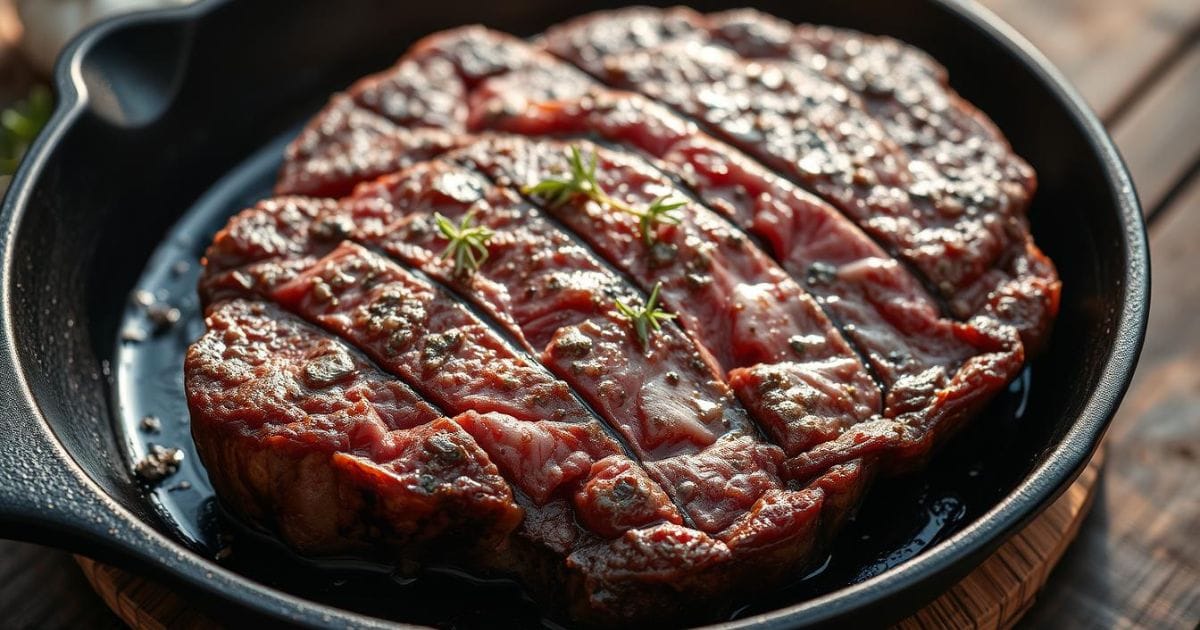The first time I saw a chef turn a bavette steak into a masterpiece, I was amazed. It’s magical when you learn to cook this special beef cut. It makes a simple meal into a memorable dining experience.
Bavette steak is a hidden gem in the beef world. It has a deep beef flavor that excites both home cooks and chefs. To cook it well, you need patience, skill, and a love for quality meat.
Meat enthusiasts will find that bavette steak is more than just a protein. It’s a blank canvas for your cooking creativity. With the right techniques, you can bring out its rich flavors and tender texture. This turns a regular dinner into a meal that wows everyone.
This guide will teach you all about bavette steak. You’ll learn how to choose, prepare, and cook it. You’ll become confident in making dishes that rival those in restaurants, right in your kitchen.
Table of Contents
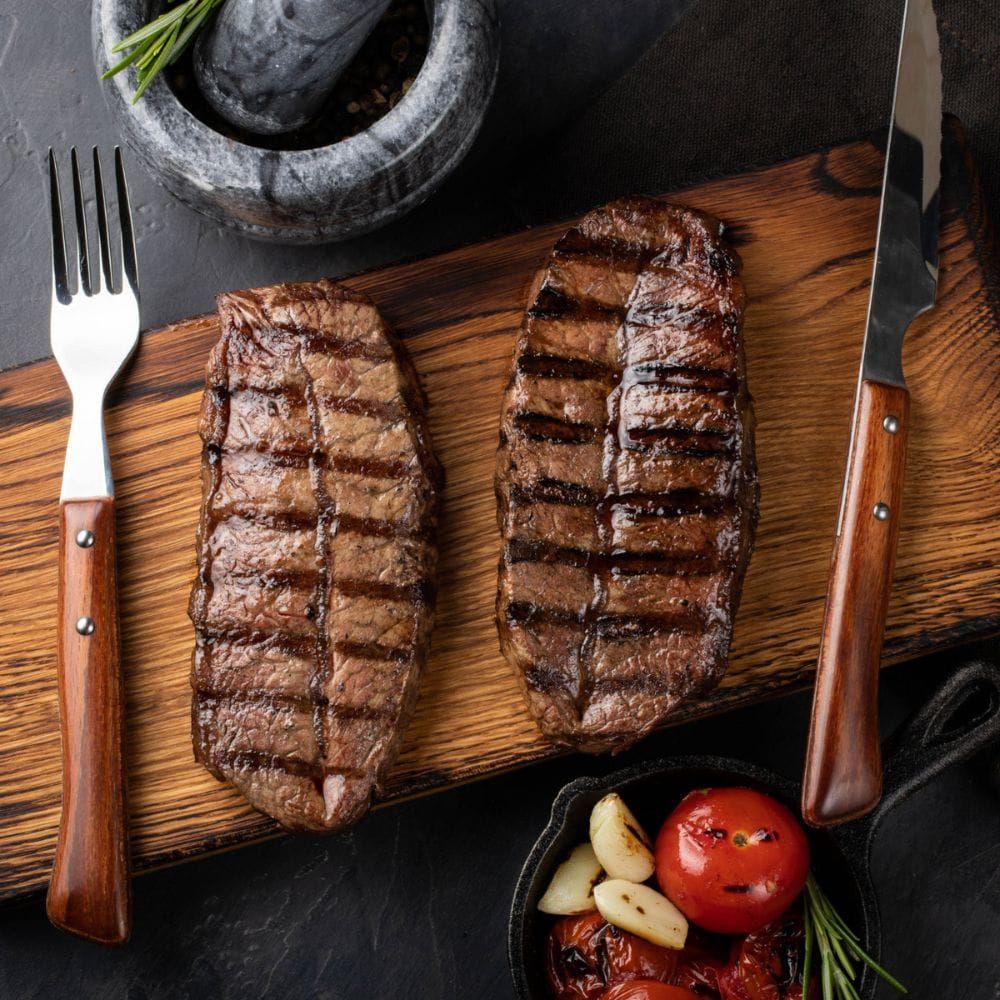
Restaurant-Quality Bavette Steak at Home
Ingredients
Equipment
Method
- Remove steak from the refrigerator 30–45 minutes before cooking; pat dry.
- Season generously with kosher salt and black pepper (or apply marinade 2–4 hours in advance).
- For Grilling: Preheat grill to 450–500°F. Grill steak 4–5 minutes per side for medium-rare.
- For Pan-Searing: Heat cast-iron skillet until smoking. Add oil, then sear 3–4 minutes per side. Optionally baste with butter.
- For Reverse Sear: Preheat oven to 275°F. Cook steak on a wire rack until internal temp reaches 115°F. Finish by searing in a hot skillet until crust forms.
- Remove steak when it’s 5°F below target temperature (125°F medium-rare, 130°F medium).
- Rest 5–10 minutes before slicing.
- Slice thinly against the grain and serve with sauces or sides.
Notes
- Bavette steak is also called flap steak, sirloin flap, or vacio.
- Best enjoyed medium-rare to medium for tenderness.
- Always slice against the grain to keep it tender.
- Store leftovers in airtight containers for up to 3–4 days; reheat gently in oven or skillet.
- Complements well with chimichurri or béarnaise sauce, plus sides like garlic mashed potatoes, roasted vegetables, or fresh salad.
Understanding Bavette Steak: The Butcher’s Hidden Gem
The bavette cut is a culinary treasure often overlooked by home cooks. It’s prized by chefs and butchers for its unique flavor and texture. This steak can make any meal special.
Origins and Alternative Names
The bavette cut comes from the bottom sirloin of the cow. It’s loved for its rich taste and special features. It’s known by different names in various places:
- Flap steak
- Sirloin flap
- Bottom sirloin bavette
- Vacio (in Argentine cuisine)
Location and Cut Characteristics
The bavette cut is found in the bottom sirloin. It has a loose grain that soaks up marinades and seasonings well. This makes the meat taste incredibly rich.
| Characteristic | Description |
| Muscle Group | Bottom Sirloin |
| Grain Structure | Loose and Open |
| Flavor Intensity | High |
| Recommended Cooking Methods | Grilling, Pan-Searing, Reverse Sear |
Meat Quality and Marbling
The bavette cut is known for its great marbling. This adds to its flavor and tenderness. It’s not as tender as some cuts, but its beefy taste and ability to take marinades make it a hit.
Professional tip: The loose grain of the bavette cut allows it to develop an incredible crust when seared at high temperatures, creating a delightful textural contrast.
Essential Equipment and Tools for Perfect Bavette
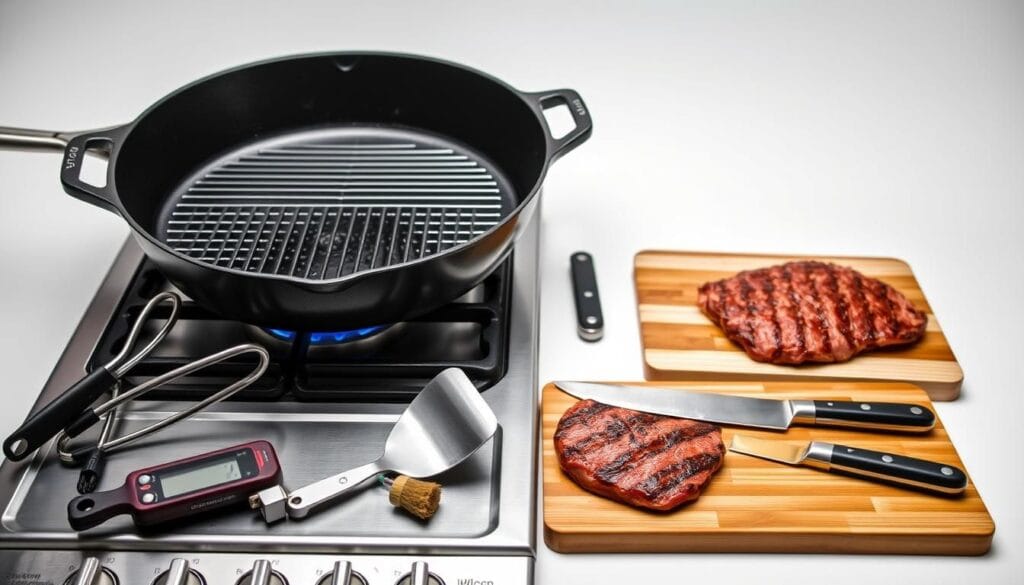
Preparing beef bavette needs specific kitchen tools to improve your cooking. The right gear can turn a simple steak into a culinary work of art. Both professional chefs and home cooks know the value of choosing top-notch cooking tools.
For bavette grillen, you’ll need a few key tools:
- Cast-Iron Skillet: The top choice for a perfect sear on beef bavette
- Digital Meat Thermometer: For precise internal temperature
- Heavy-Duty Tongs: Safe for handling and turning meat
- Sharp Chef’s Knife: Essential for slicing after cooking
- Cutting Board: Best made of wood or high-quality plastic
Choose durable, professional-grade tools for bavette grillen. A top-notch cast-iron skillet spreads heat well and makes a great crust. A digital meat thermometer ensures you cook to the perfect doneness.
More tools you might want include:
- Grill or smoker for different cooking ways
- Instant-read thermometer for quick checks
- Meat resting rack to keep steak quality
Having the right equipment makes cooking beef bavette a gourmet experience. Each tool is vital for bringing out the best in this special cut of meat.
Preparing Your Bavette Steak for Cooking
Starting a great bavette steak recipe is all about preparation. It’s key to turn this tasty cut into a dish that will wow everyone.
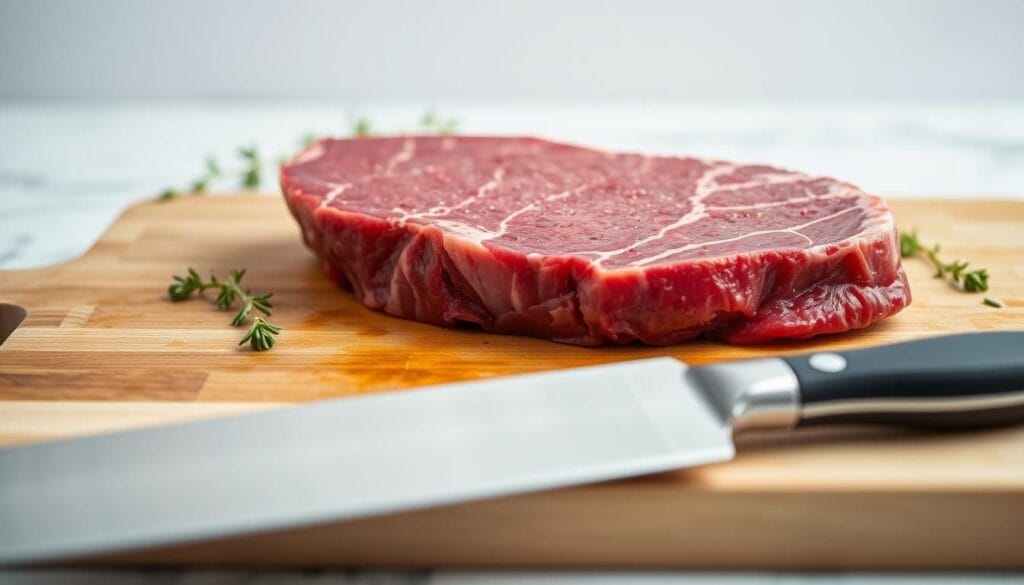
Proper Tempering Techniques
Tempering your steak is essential for even cooking and tenderness. Take the steak out of the fridge 30-45 minutes before cooking. This lets it warm up evenly, avoiding tough spots.
- Remove steak from refrigerator
- Pat dry with paper towels
- Let sit at room temperature for 30-45 minutes
- Place on a clean cutting board
Seasoning Methods and Timing
Seasoning is crucial for a great bavette steak. Season it just before cooking for the best taste. A mix of kosher salt and black pepper is a classic choice.
| Seasoning Approach | Timing | Flavor Impact |
| Salt and Pepper | Immediately before cooking | Classic, robust flavor |
| Dry Rub | 30 minutes before cooking | Complex, layered taste |
Marinade Options and Benefits
Marinades can add to the steak’s flavor. Acidic ingredients like vinegar or citrus can tenderize the meat. This makes the steak even more enjoyable to eat.
- Garlic and herb marinade
- Soy and ginger blend
- Balsamic and rosemary mixture
Each marinade offers a unique taste that goes well with the steak. This lets you try different flavors and make the dish your own.
The Art of Seasoning and Marination
Seasoning a bavette steak needs a gentle touch to bring out its rich flavor. Its grain structure is perfect for soaking up marinades and seasonings. This cut’s loose fibers make it a great base for flavors.
Expert chefs suggest several seasoning methods for flank and bavette steaks:
- Use coarse kosher salt for initial seasoning
- Apply freshly ground black pepper
- Experiment with herb-based dry rubs
- Consider quick marinades that complement the meat’s natural taste
Creating a great marinade is about finding the right balance. A classic mix might include:
| Ingredient | Quantity | Purpose |
| Worcestershire Sauce | 3 tbsp | Adds depth and umami |
| Garlic | 2 cloves | Provides aromatic flavor |
| Olive Oil | 2 tbsp | Helps distribute seasonings |
| Fresh Herbs | 1/4 cup | Enhances overall taste profile |
Pro tip: Marinate bavette steak for 2-4 hours to keep it tender. The aim is to boost, not hide, the steak’s natural taste.
The secret to perfect bavette steak lies in understanding its unique characteristics and treating it with respect.
Cooking Methods for Bavette Steak
Learning how to cook bavette steak is key. It’s about finding the right cooking techniques. These methods bring out the steak’s rich flavor and tender texture.
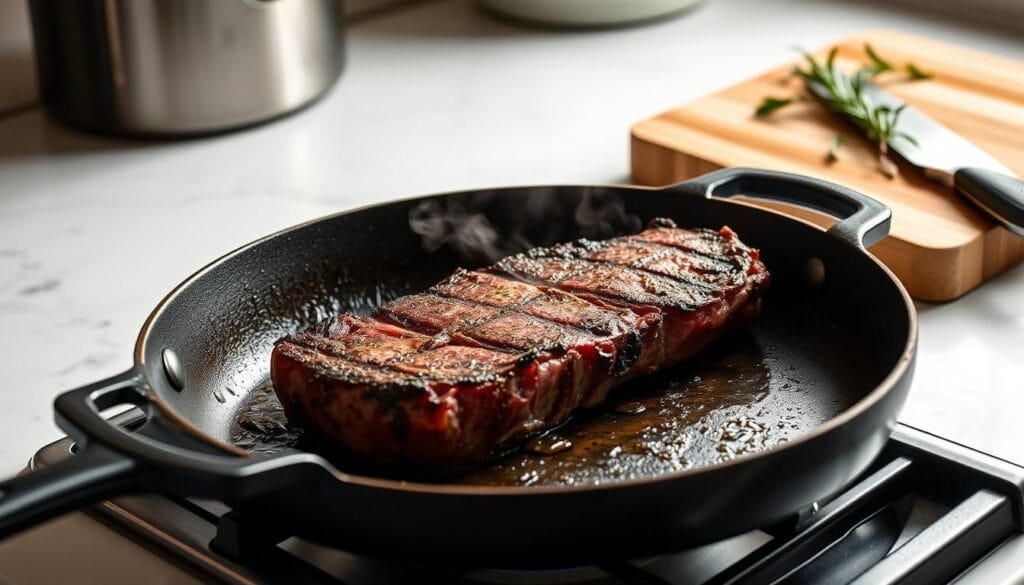
There are many ways to cook bavette steak, each with its own charm. Chefs say there are three main methods that always work well.
Grilling Techniques
Grilling bavette steak gives it a tasty outside and a juicy inside. Here’s how to do it right:
- Preheat grill to high heat (450-500°F)
- Pat steak dry with paper towels
- Season generously with salt and pepper
- Grill 4-5 minutes per side for medium-rare
- Rest meat for 5-7 minutes before slicing
Pan-Searing Steps
Pan-searing makes the steak crispy on the outside and flavorful. Here’s what to do:
- Use a cast-iron skillet for best results
- Heat pan until smoking hot
- Add high smoke-point oil
- Sear 3-4 minutes per side
- Baste with butter during final minutes
Reverse Searing Process
Reverse searing lets you control the steak’s temperature perfectly. It involves cooking the steak slowly in the oven first, then searing it quickly.
- Preheat oven to 275°F
- Place steak on wire rack
- Cook until internal temperature reaches 115°F
- Finish with high-heat sear in cast-iron skillet
- Achieve beautiful golden-brown crust
Pro tip: Always let your bavette steak rest after cooking. This helps the juices spread and makes it tender.
Temperature Guidelines and Doneness Levels
Getting the perfect temperature is key for a tasty beef bavette. This cut needs careful attention to be tender and flavorful. Knowing the right doneness levels can make your bavette steak recipe stand out.
The best temperature for bavette steak is between medium-rare and medium. These temperatures keep the meat juicy and full of flavor.
- Medium-rare: 125°F – Recommended for maximum tenderness
- Medium: 130°F – Provides slightly more cooked texture
- Below 125°F: Risks undercooking
- Above 135°F: Risks becoming tough and dry
Being precise with temperature is what sets good cooks apart from great ones. A reliable meat thermometer is essential for cooking beef bavette.
| Doneness Level | Internal Temperature | Meat Characteristics |
| Rare | 120-125°F | Very red center, soft texture |
| Medium-Rare | 125-130°F | Warm red center, ideal for bavette |
| Medium | 130-135°F | Pink center, slightly firmer |
| Medium-Well | 140-145°F | Slight pink, more firm |
Letting your bavette steak rest after cooking is just as important. Give it 5-10 minutes to let juices redistribute and temperature stabilize. This step makes the steak more juicy and flavorful.
Pro tip: Remove bavette steak from heat when it’s 5°F below your target temperature, as it will continue cooking during the resting period.
Creating Complementary Sauces and Accompaniments
Improving your bavette steak experience is more than just cooking it right. The right sauce can turn a tasty top sirloin cap into a true masterpiece. Choosing the perfect side dish can also boost the meat’s rich flavors.
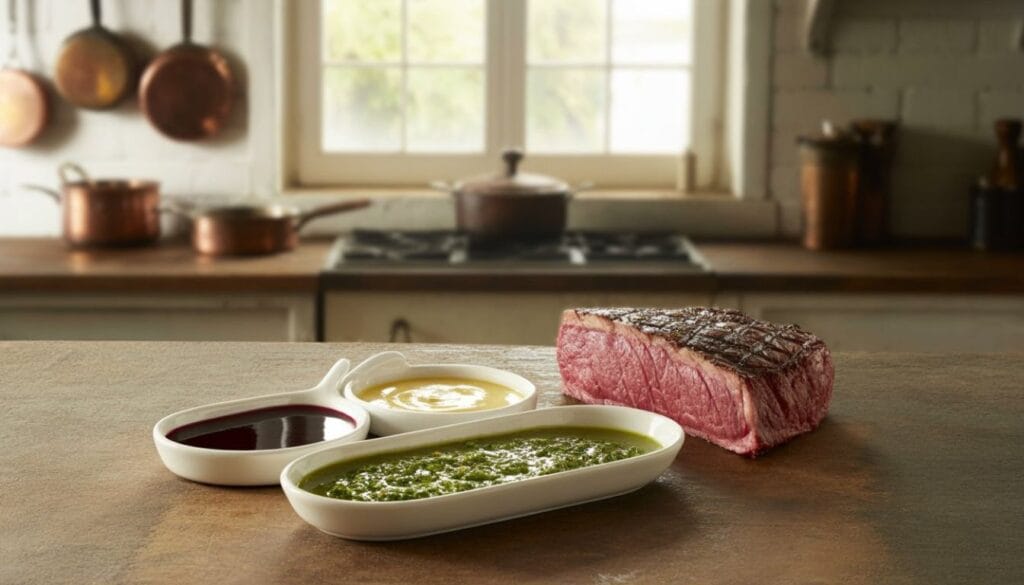
Finding the perfect sauce means knowing the bavette steak’s bold taste. The top sirloin cap’s rich flavor is a great base for both classic and new sauce ideas.
Classic Sauce Recipes
- Chimichurri Sauce: A zesty Argentine-style sauce with fresh herbs
- Traditional Béarnaise Sauce: Buttery and elegant complementing technique
Modern Flavor Combinations
Today’s chefs are exploring new sauce pairings. Green Peppercorn Cream Sauce, for example, adds a rich, complex taste that goes well with the bavette steak.
- Roasted Garlic Aioli
- Smoky Chipotle Cream
- Green Peppercorn Cream Sauce
When making sauces, it’s all about balance. You want to add to the steak’s flavor, not hide it.
Slicing Techniques and Presentation Tips
Learning to slice bavette steak right can turn a simple meal into a work of art. This butcher’s steak needs precision and care to reveal its tenderness and flavor.
Finding the meat’s grain is key to making the bavette cut delicious. The muscle fibers run in a specific direction. Cutting against these fibers makes the steak tender.
- Locate the direction of muscle fibers
- Use a sharp knife with a long, smooth blade
- Cut perpendicular to the muscle grain
- Slice thin, consistent pieces (about 1/4 inch thick)
“The secret to a perfect bavette steak is in the slice – thin, against the grain, and with surgical precision.” – Professional Chef
How you present the steak is just as important as how you slice it. Place the sliced steak on a warm platter, spreading it out to show off its color and texture. Add some fresh herbs or a drizzle of oil to make it look even better.
Let the sliced bavette steak rest for a few minutes before serving. This lets the juices spread evenly, making each bite juicy and full of flavor.
Side Dish Pairings and Menu Suggestions
Choosing the right sides for your bavette steak recipe is key. It makes the dish even more enjoyable. A well-cooked flat iron steak needs sides that match its bold flavor.
Classic steakhouse sides make a great meal. Here are some tasty options:
- Creamy garlic mashed potatoes
- Roasted seasonal vegetables
- Crisp arugula salad with balsamic vinaigrette
- Grilled asparagus with parmesan
Want to try something new? Bavette steak works well with many cuisines. Try these exciting dishes:
- Spicy Mexican fajitas
- Asian-inspired stir-fry
- Hearty steak salad
- Rustic street taco platter
When planning your menu, balance is important. Match the bold flavor of bavette steak with lighter sides. A zesty chimichurri sauce or fresh herbs can make it even better.
Pro tip: Always let your bavette steak rest before slicing to ensure maximum juiciness and flavor retention.
Storing and Reheating Leftover Bavette
Keeping the taste of bavette steak fresh is key. You need to store and reheat it right. This way, your leftover hanger steak stays tender and tasty for later meals.
- Cool the steak completely before storage
- Use airtight containers or vacuum-sealed bags
- Refrigerate within two hours of cooking
- Store for maximum 3-4 days in the refrigerator
When reheating your leftover bavette steak, be gentle. Microwaves can dry out the meat fast.
| Reheating Method | Best Practices | Recommended Temperature |
| Oven Method | Use low heat, cover with foil | 250°F (120°C) |
| Skillet Technique | Quick sear with minimal oil | Medium-low heat |
| Sous Vide | Precise temperature control | 130-135°F (54-57°C) |
Get creative with your leftover bavette steak. Slice thinly for salads, chop for stir-fries, or create gourmet sandwiches. This way, you can enjoy it in new and exciting ways.
Pro tip: Always let reheated steak rest for 3-5 minutes before serving to redistribute internal juices.
Conclusion
Learning to cook bavette steak turns an affordable cut into a top-notch meal. This versatile flank steak is a tasty choice for those who love beef. It shows that skill is more important than the price.
Getting it right is key for tender, tasty results. From choosing the right seasonings to controlling the temperature, home cooks can make bavette steak special. This guide helps you bring out the best in this underappreciated beef cut.
Try different marinades, cooking methods, and ways to present it. Each try teaches you something new, making your meals unforgettable. Remember, practice and patience are your best friends in mastering bavette steak.
We encourage all home cooks to take on the challenge of mastering bavette steak. Share your experiences, techniques, and favorite recipes with others. Your journey with this delicious steak is just starting.
FAQ
What is bavette steak?
Bavette steak is a tasty, lesser-known beef cut from the bottom sirloin. It’s also called the butcher’s cut. It has a loose grain and lots of marbling, making it very flavorful when cooked right. It’s like flank steak but often softer and tastes deeper.
How should I cook bavette steak for the best results?
To cook bavette steak well, use high-heat grilling, pan-searing, or reverse searing. Cook it to medium-rare or medium. Use a meat thermometer to get the right temperature. Let it rest before slicing against the grain for tenderness.
What makes bavette steak different from other cuts?
Bavette steak is special because of its grain and flavor. It’s cheaper than cuts like ribeye but tastes great. Its loose fibers soak up marinades and seasonings well.
What are the best marinades for bavette steak?
Good marinades include chimichurri, garlic and herbs, and soy-based Asian marinades. Its loose fibers soak up flavors fast. Marinate for 2-4 hours to boost flavor without hiding the beef taste.
How do I know when bavette steak is cooked correctly?
Check the internal temperature with a meat thermometer. Aim for 130-135°F for medium-rare, 140-145°F for medium. It should have a brown crust and a pink center. Let it rest for 5-10 minutes after cooking.
Can I freeze bavette steak?
Yes, you can freeze bavette steak. Wrap it tightly in freezer-safe packaging. It can last 3-4 months in the freezer. Thaw it slowly in the fridge before cooking to keep its quality.
What are the best side dishes to serve with bavette steak?
Good sides include roasted veggies, garlic mashed potatoes, and grilled asparagus. Also, fresh salads and crispy potato wedges are great. The steak’s strong flavor goes well with many sides.
How should I slice bavette steak?
Always slice against the grain for tenderness. Cut perpendicular to the muscle fibers. This makes the steak tender and easy to chew.
There are no reviews yet. Be the first one to write one.
Have you tried this recipe?
There are no reviews yet. Be the first one to write one.

